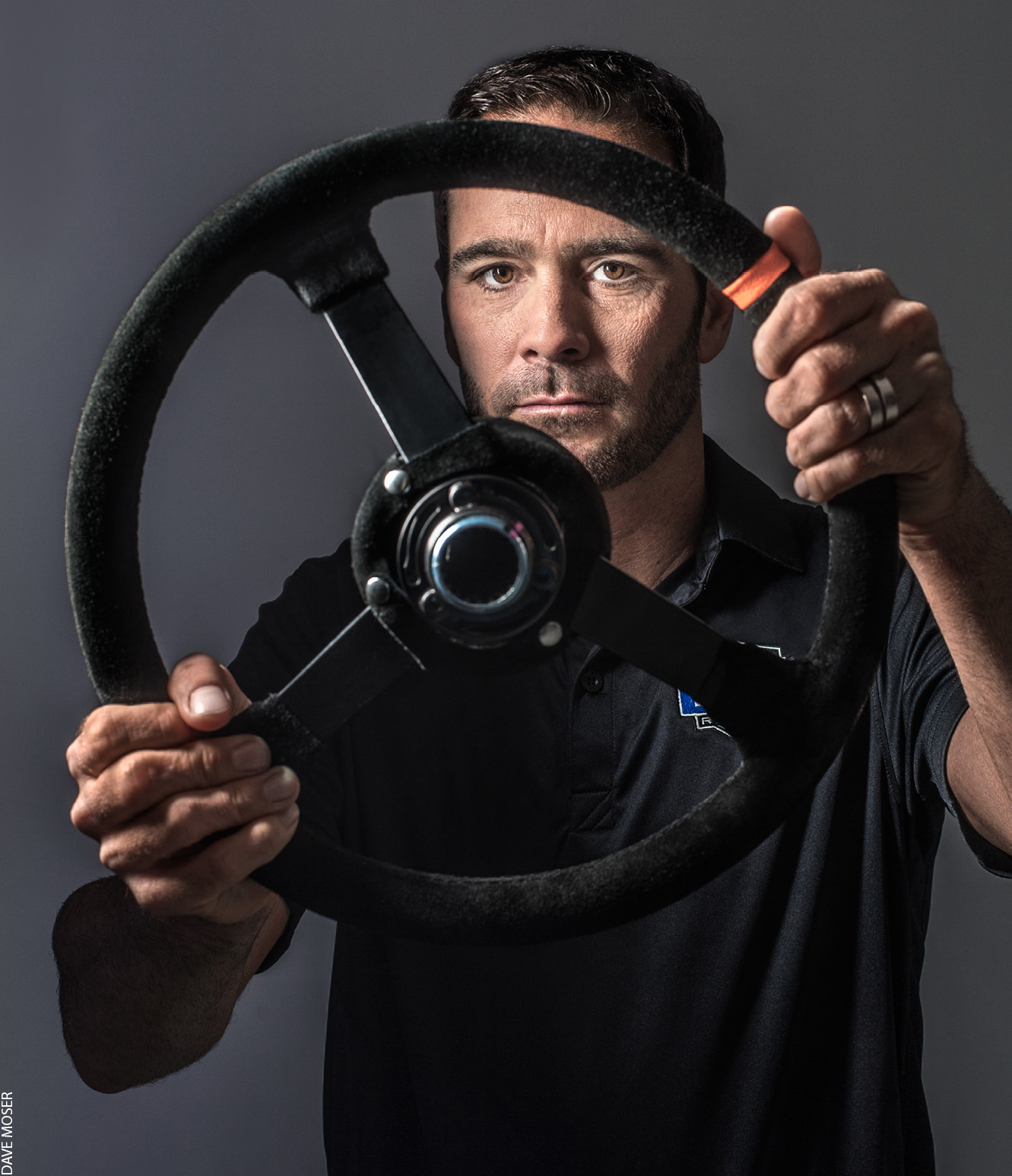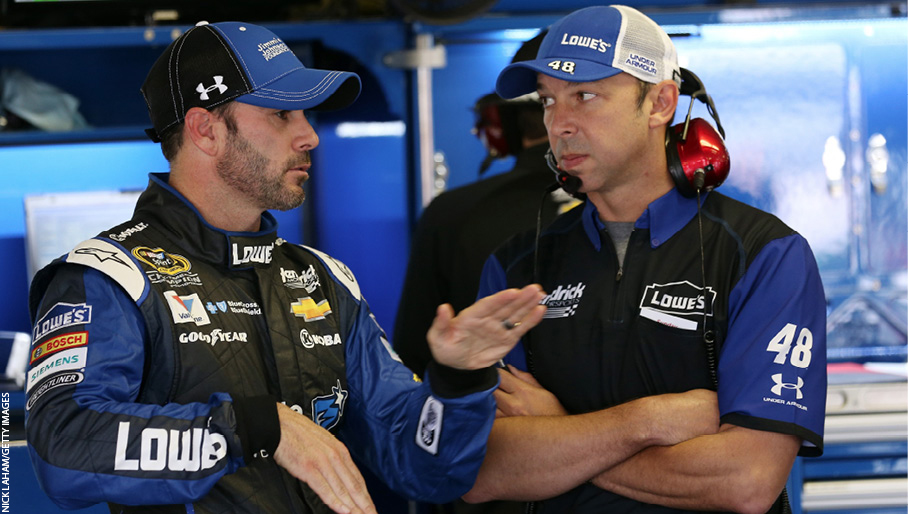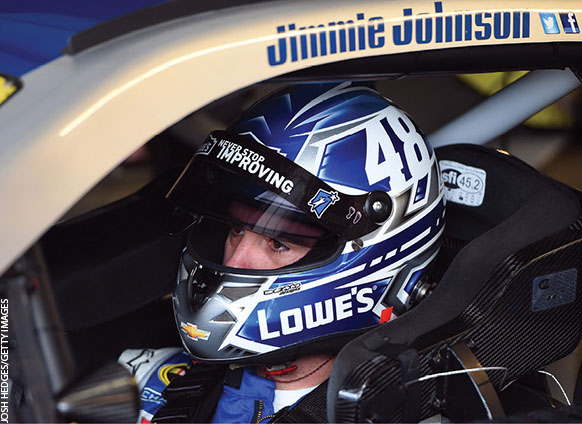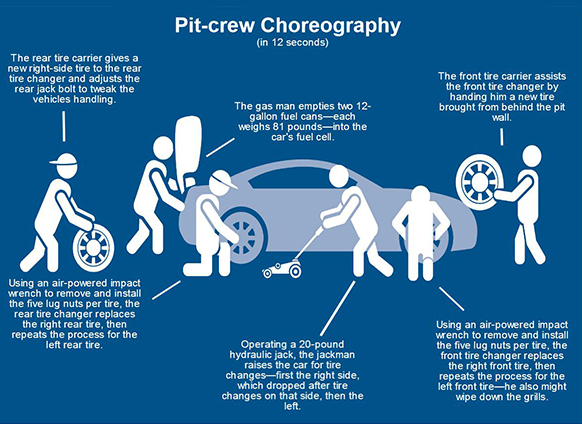The moment of clarity came as he drove 100 mph over a cliff.
Jimmie Johnson, the most successful NASCAR driver of the last three decades, like most in his occupation started with a pedal-to-the-metal, no-holds-barred approach to every race.
“I began my career as a young guy racing dirt bikes in relatively short events, then moved into the off-road trucks, again at very short distance races,” Johnson says. “We were racing in stadiums all around the country, and the race is eight minutes long. You go at 100 percent immediately, hard as you can, caution to the wind. That approach is very specific to that kind of racing. Then I moved into the off-road desert or endurance races. It was 1995, I was 19, and suddenly was in a 1,000-mile race in Baja, Mexico. It took the winner 26 hours to complete. Yet I was out there driving at 100 percent, treating it like it was an eight-minute race.
“It turned into one of those moments when I was slapped in the face.… Either I change, or I may not live,” the six-time Sprint Cup Champion reminisced as he recounted his aha moment.
Related: 10 Things Successful People Never Do Again

“That year, in that division of racing, I had a couple of big crashes,” Johnson says. “In one, I destroyed this truck at the first mile marker of a 400-mile race, ripped the suspension off the truck. I knew then that I wanted to have a career in stock car racing, where you’ve got the 600-mile race in Charlotte and a lot of 500-mile races. I was just so caught up in being fast, aggressive. There’s a time and place for it, but I didn’t understand the balance. I was on the wrong side of 100 percent. If I can’t go past the first mile of a desert race, why would anyone trust me to succeed in a 500-mile race? But I didn’t learn my lesson.”
A terrifying moment during the infamous Baja race changed everything.
“There’s an old saying in racing: In order to finish first, first you must finish. I had to realize that pushing the limit isn’t always the way you succeed.”
“Baja is a true test of endurance. I was young, and decided I was going to drive straight through,” says Johnson, shaking his head. “The next morning about 3 a.m., I was powering through with a mechanic in the seat next to me. We were leading the race. I had passed one checkpoint about 40 or 60 miles back, and then there was a pit stop another 40 miles ahead. The radio we had in the truck didn’t work well in the mountains, and the chase vehicle that was traveling with us had a fender bender in a small town so the Mexican police had arrested them. All that to say we were all alone and going more than 100 mph.
“Then I dozed off. I didn’t fall asleep. I just dozed off for a few seconds. But I woke up, and I had missed a turn.”
His Chevrolet pickup somersaulted over a cliff. The truck flipped three times before landing on a pile of rocks. The roll cage was ripped from the chassis. All four tires exploded.
Johnson jokes that he was “fully awake” at that point and stunned to realize he wasn’t significantly hurt. His mechanic was safe, too. They pulled themselves from the mangled wreckage and staggered to a spot where they looked back—and up—to assess the moment. Johnson’s team needed an entire day to find him and the mechanic.
“No doubt that time sitting there reframed things for me,” Johnson says. “There’s an old saying in racing: In order to finish first, first you must finish. I had to change the way I approached what I did. I had to realize that pushing the limit isn’t always the way you succeed.
“I sat there and used that moment—actually that whole day—to get my arms around the changes I had to make. I didn’t flip a truck those last two years I was dirt racing. It changed me that quick. I was finally at 100 percent. I had been at 110 percent, making mistakes, driving over my ability level, driving over the vehicle’s level, just way on the wrong side of it.
“Once I brought it back and drove in control, I made fewer mistakes, became more successful, began winning more races. I wasn’t breaking the equipment, and now we’re finishing races. And oh, hey, gosh, everybody else broke. Looks like I won.”
When others ask the magic to his success, Johnson says it “doesn’t sound sexy” to explain that what made him faster was actually learning to back off, if ever so slightly. But that night in Baja, the lesson that spawned championships became clear as the sky above.
***
Understand this: Those who make the rules in NASCAR often do so to prevent dynasties, constantly tweaking the standards so that every week, every season, there is a new opportunity for teams to win. But over the eight-year window from 2006 to 2013, members of Johnson’s team took whatever rules were laid out for them and beat everyone else to win six championships. From 2006 to 2010, he won an astounding five straight titles, delivering what many consider the greatest run in all of sports.
Dominance? Johnson, 40, has been participating at his sport’s highest level since 2002, yet he is already considered among the greatest ever. In 2015 he earned his 200th top-five finish and 300th top-10 finish. He has made his way to the winner’s circle 74 times. No one else is even close in the same sport.
“I know there are Patriots fans or Yankees fans who might disagree,” says driver Jeff Gordon, another NASCAR legend. “But I think what Jimmie did winning five straight championships is one of the great feats ever. Think of all the things that can go wrong over a NASCAR season—crashes, engine problems, pit crew problems… even a lug nut coming up under a car and causing damage. To manage all that for five straight years and be the best? That’s ridiculous.”
How do you win so consistently in a sport that is built to keep it from happening? “We have a great team,” Johnson says matter-of-factly. “And we are constantly adjusting, working to get better. Last year’s accomplishments are just that… last year’s. Heck, last week’s accomplishments don’t mean much around here.”
As Johnson walks down the hallway at his Hendrick Motorsports office in North Carolina, where he makes his home with his wife Chandra and two daughters, past those six gleaming trophies and pictures from his championship years, he looks through the glass wall at the spotless garage where his team is preparing cars for upcoming races. “It all starts with Chad Knaus,” says Johnson, referring to his crew chief as he nods toward the sprawling space with a dozen cars emblazoned with 48, the team’s number, in some state of construction.
Knaus is Johnson’s polar opposite. Where Johnson is California Cool, Knaus is a ball of energy with a Chicago accent. Where Johnson is measured, Knaus is direct. Their similarity: Both are perfectionists and competitive as can be.

“Chad loves to win. Period,” Johnson says.
“Jimmie is a racer, and he just wants to win,” Knaus echoes. “We want to win, and we want to win championships. We don’t accept anything less.”
Early in their relationship, that combination of differences and similarities produced friction. One of the great conundrums of the sport is that crew chiefs want to build the fastest car, and drivers want a car they can control comfortably. Both can get close to their desires only if they communicate clearly with one another.
Yes, the greatest team in the history of stock-car racing was constructed not in a garage, nor on an oval track. It blossomed over a table of Mickey Mouse plates, milk and chocolate chip cookies.
Rick Hendrick, owner of Hendrick Motorsports, paired Knaus and Johnson in 2002. The boss tasked them with chasing championships alongside Hendrick’s all-star list of drivers, including Gordon and, later, Dale Earnhardt Jr. But by 2005, the lines of communication between Johnson and Knaus had frayed so severely that the trust required to work well together was broken. And as important as trust is in most business collaborations, it is paramount when your workplace is flying around a track at 200 mph.
Hendrick intervened, and in the process, generated one of the best sports stories of all time.
“Rick’s big conference room is just down the hall,” Johnson says. “In ’04 we had almost won a championship. In ’05 we were very close again. The pressure grew because you never know how many times you’re going to get that chance.

“Chad and I were just on each other—very short fuses, talking aggressively to one another. I guess from an outsider listening in, we were acting like kids, like brats, just fighting with each other over petty things. Our desire to succeed was so great that anything that would normally have been a 1 on your frustration scale was a 10 on ours. Everything was an explosion, and we were virtually not talking. We’re just going through the motions at the track. I’m communicating what I feel with the car; he’s responding back. But we were using as few words as possible. Our sport is so people-based that energy and vibe, that dynamic, is very real for us.
Related: 5 Tips to Handle Conflict When You’re Working With Your Polar Opposite
“At that time, everything was off.
“Rick listened to it enough on the radio at the racetrack that one morning he called a last-minute meeting,” Johnson says. “He called me and said, ‘I’ll see you in my office in an hour.’ I knew Chad was going to be there and was pretty sure I was going to get a butt-chewing.
“I walk in the room. I see a huge pile of cookies, a gallon of milk, two Mickey Mouse plates, Mickey Mouse napkins. Mr. Hendrick greets us, looked at me and said, ‘All right, you sit over there. Chad, you sit here.’ So we sit down at these Mickey Mouse plates. He said, ‘All right, boys, have some cookies.’ I looked at him, confused. ‘I’m serious. Have some cookies. I’m going to pour you some milk.’ He pours us milk; we get the cookies. He’s not happy, so he gets a bit more aggressive as the moments go by. ‘No, eat those cookies. Take a drink of that milk. Come on, you two act like kids. I’m going to treat you like kids.’ ”
Hendrick made his point, Johnson says. After a few minutes—and smiles, as the point sank in—the kids began talking.
“He broke us in a very polite and constructive way,” Johnson says. “The energy started to change, and we opened up. He was like, ‘All right, you two have got to stop this.’ We definitely deserved a lecture, but I’m not sure a lecture would have done as much as those plates of cookies to make his point. It was just a brilliant icebreaker to kind of change the energy, to prove a point. Instead of yelling and screaming, it was just done in a very creative way.
“That was definitely a starting point because for the first time in a while, we actually talked,” Johnson says. “Chad opened up and shared stress factors he was facing. I did, too. We both admitted that we had been pushing each other’s hot buttons.
Johnson says he and Hendrick gained an appreciation that day of Knaus’s work schedule, and the owner made decisions to change staffing levels to help. “Chad was literally up 20 hours a day, seven days a week trying to make it all work,” Johnson says. “That was enlightening to me to see what was leading to the big stress in his life. Before that day, we had never discussed it. Not knowing that before, I took everything he said with a certain tone in his voice as an attack, and I attacked back.
“You can imagine how well that worked.”
As Knaus opened up about his need for help, he also acknowledged that he’d have to do less micromanaging of the team once Hendrick gave him new staff. All those changes proved fortuitous at the start of the 2005 season, when NASCAR suspended Knaus for improper alterations to a car. The three-week penalty could have been disastrous, but the time spent reconfiguring the team after the milk-and-cookies summit meant the team was capable of competing effectively without its crew chief.
“Through that offseason, we empowered everybody on the race team,” Johnson says. “And even in Chad’s absence, we were able to still function and operate as a race team, and we won two of the three races. Funny how things work, but that meeting led to a massive change in how we operated. We were immediately tested when Chad was suspended. But once he came back, we had a chance to finally work together in a streamlined setup, and we strolled on to win our first championship.
“Then we won four more after that. Five in a row.
“I lived it, and I still don’t believe it.”
Yes, the greatest team in the history of stock-car racing was constructed not in a garage, nor on an oval track. It blossomed over a table of Mickey Mouse plates, milk and chocolate chip cookies.
Nearly as impressive as the team’s run of success is another factor Johnson and Knaus believe contributed mightily: Unique to NASCAR, the 48 team suffers almost no turnover. Where others in the sport watch a revolving door as key employees flow in and out, spots on Johnson’s Lowe’s-sponsored team almost never open. Several members of Johnson’s team have turned down better jobs to stay and be part of his dominant run.
“The team sees kind of person he is…. They know he appreciates what they do and cares about them.”
Hendrick explains the key to that stability: “Jimmie knows you need everyone clicking to win in this sport, but it’s also in his DNA to treat others with respect and give credit to the people who support him. That comes naturally to him. It’s real. He’s one of the greatest drivers ever and, at the same time, one of the nicest, most humble people I know. The team sees the kind of person he is, how hard he works and what he himself invests in their success. They know he appreciates what they do and cares about them as individuals because he shows it. At the same time, he’s working just as hard as they are and setting that tone for everyone around him. People respond to that.”

Being personable and humble provides Johnson with an additional edge on race days, too, Hendrick says. The driver is so well-liked by his peers that he’s rarely the target of aggressive driving, which translates into fewer accidents and more completed races.
Remember: To finish first, first you must finish.
***
With all the success comes the inevitable “what’s next” question. Johnson says his answer has changed over the years.
“I’d love to win seven championships; that’s the quest,” Johnson says, acknowledging that if he hits that total, he’ll tie Richard Petty and Dale Earnhardt Sr., NASCAR’s most iconic drivers, for the most titles ever.
“I promise you I want to win as much as ever, but my life has changed in ways that will make it easier to move on when that flame goes out.”
“It’s weird because I wasn’t one motivated by a number growing up, and now I’ve got this huge opportunity that’s in front of me. So now I’m faced with that for the first time in my life. I’ve always been about the experience in the car and the fun that I have racing. Now I have to admit I do think about the number seven once in a while.”
But Johnson says age, marriage and parenthood have given him perspective as he pursues that record-tying championship.

“I promise you, I want to win as much as ever, but my life has changed in ways that will make it easier to move on when that flame goes out,” he says while staring at a ledge filled with hats and memorabilia awaiting his autograph. “I have other goals like being a great dad. I want to do a full Ironman. I want to run the New York marathon, things like that. I don’t have some desire to run a company. I see guys, and props to them, but they retire from sports, and they want to practice law. That’s not me.”
And what will he drive when he hands over the keys to his 900-horsepower Chevy race car?
“Something that will look good in the carpool lane,” says Johnson, flashing a grin. “I drive the kids to school now every day that I can. It is actually a pretty awesome experience. There are some other drivers who live in the area, so occasionally we’ll have Jeff Gordon, Casey Mears and myself—three Sprint Cup drivers—sitting there with a whole bunch of moms picking up our kids.”
When the bell rings and Johnson’s daughters, Genevieve and Lydia, race to the car, those are also clarifying moments for him, ones that set and reinforce his priorities. Fortunately they don’t occur at 100 mph.
Related: 5 Ways Fuel Your Crew’s Success The Jimmie Johnson Way
Jimmie Johnson is featured in March 2016 issue of SUCCESS magazine; on newsstands Feb. 9.


